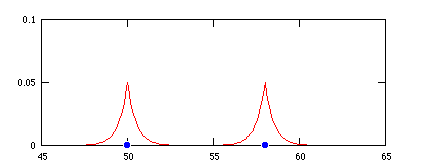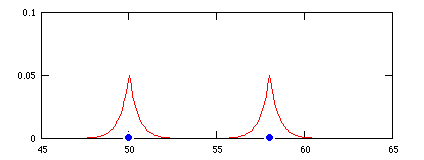
Linear combinations of 1s atomic orbitals about
nucleus "a" and nucleus "b" to approximate a
molecular orbital about both nuclei.
What is shown below is a simulation of two hydrogen-like 1s
atomic orbitals in one dimension. This is essentially an exact
animation in one dimension of what appears in FIGURE 14.25.
(Ignore the labels on the x- and y- axes.) One atomic orbital
(call it 1sa) is located at "50" on the
x-axis and the other (call it 1sb) starts at
"58". The form of the 1s wave function (see text Table
12.1) is e-x where x is the displacement from each
nucleus' location and where the atomic wave functions each peak.
The total square of the wave function for an electron about both
nuclei is calculated as (1sa + 1sb)2.
This corresponds the the electron's density distribution in the
approximate molecular orbital since it is the square of the wave
function. Note the accumulation of density in the region between
the nuclei as "b" is moved closer to "a" and constructive
interference occurs, keeping the area under the density
distribution constant (so that it always corresponds to 1.00
electrons). An electron occupying this molecular orbital at the
final frame would be in a binding situation.

Now we do the same but take the other linear combination, (1sa
- 1sb)2, corresponding to destructive
interference as "b" is moved closer to "a",
again keeping the area under the resulting density distribution
unchanged. An electron in this molecular orbital would be in an
antibonding situation. Note that density is removed between the
nuclei because of destructive interference and accumulates on the
outside regions of the one-dimensional system.
